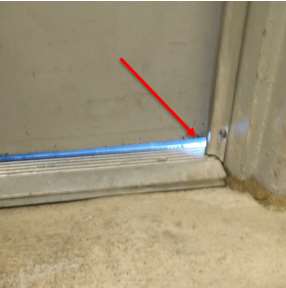Am I really not strong enough to open the doors in my Condo?
Before going to the gym, answer yourself this:
- Is your condo a multi-storey building?
- Is the air temperature outside significantly different than inside?
If so, your building is likely suffering from a common issue known as stack effect, a phenomenon that can cost your condo money and annoy your residents. The good news: there are ways to mitigate stack effect and realize cost savings at the same time.
What is stack effect?
Stack effect is a pressure difference created by the buoyancy of air when there is a temperature difference between the exterior and interior of tall buildings. The greater the temperature difference and the taller the building, the greater the buoyant force, and the greater the stack effect. This phenomenon is also known as the “Chimney Effect” since tall buildings act like a chimney whereby, in winter, cold air enters at the bottom of the building, and warm air rises to the top of the building.

Stack effect has many negative consequences. Air infiltration at the bottom of the building makes it difficult to open doors, causing electric doors to malfunction. Air exfiltration at the top of the building causes air leakage and increased building energy use. Although it is typically less noticeable due to smaller temperature differences, stack effect is reversed in the summer; warm air enters at the top of the building, and forces cold air out of the building at lower floors. This can cause elevators to overheat or even malfunction.
How do you reduce or eliminate the stack effect in your building?
It’s simple. Just seal every opening in the building and never open any windows or doors. Okay, maybe not so simple, but there are some basic first steps that you should consider:
-
Educate Residents
The residents play a key role in limiting stack effect in the building. Educate residents on the importance of keeping windows and doors closed during the winter, to use revolving doors, and to make sure stairwell doors and garbage chutes remain closed. -
Building Entrance and Exit Doors
Check for any openings in the frame, or the transition from the door to the door frame. Be quiet and listen for any whistling noises. Possible repair options include: installing weatherstripping, sealing gaps, installing a second set of doors so that only one set of doors is open at a time, and installing revolving doors.

-
Garage Lobby Entrance and Exit Doors
Like building entrance doors, check for any openings. Garage doors get both warm indoor temperatures, cold outdoor temperatures, and take a lot of abuse. Check for warping. Repair options include: installing weatherstripping, sealing any gaps, replacing the door, and installing a second set of doors. -
Stairwells
Unsealed stairwells are a common problem for buildings suffering from stack effect. Unsealed doors allow for air to travel from one floor to the next. Sealing the corridor-to- stairwell doors will minimize stack effect. Before starting check to make sure that the doors are in good condition and will not warp. Check for warping and alignment of the roof access doors. Repair options include: installing weatherstripping and replacing warped doors.

-
Elevator Shafts
Elevator shafts act like a large chimney, allowing air to enter from the lower levels and exit at the mechanical penthouse. Mechanical penthouses are often neglected and have openings to the outside that are not sealed. Check for any openings from the elevator shaft to the exterior, such as warped doors, open louvres, unsealed pipe penetrations, and cracks in the masonry or concrete. Check with your mechanical engineer to make sure that the proposed air-sealing does not compromise venting requirements for your mechanical equipment. -
Garbage Chutes
Garbage chutes typically run from the mechanical penthouse to the ground floor. At the mechanical penthouse, check for openings similar to the process for the elevator shaft. At the garbage room at the bottom of the chute, check to make sure there are no openings to the outside. Any openings will increase the stack effect in the building. -
Floor to Floor and Suite Penetrations
The air barrier in high-rise construction is typically the interior drywall. To be continuous and effective the drywall must be sealed at penetrations and terminations in the drywall such as electrical outlets, window perimeters, and the top and bottom of the wall. After closing all windows and doors, check for air movement using your hand or, if available, a smoke pencil. Components that often leak are shower exhaust fans, outlets, pipe penetrations such as sinks and showers, lights, the slab (floor) edge where it meets the wall, windows, and balcony doors. Seal the penetrations accordingly. Entrance doors to the suite should not be sealed with weatherstripping if there is a make-up air unit supplying air to the suites from the corridors.

Methods to reduce stack effect all follow the same principle; compartmentalize the building by eliminating vertical air transfer pathways. By sealing each floor of your building from the next and by sealing vertical shafts from the rest of the building and from the exterior, you will help maintain a constant air pressure difference between the interior and exterior of the building.
Major air leakage pathways include building entrance and exit doors, parking garage entrance and exit doors, stairwells, garbage chutes, and elevator shafts. Methods to reduce stack effect in buildings include decoupling of floors, compartmentalization of suites, pressurizing entrances to the building, weather stripping stairwell doors, and having revolving doors at building entrances.
To detect air leakage and identify cold patches, it is useful to have a smoke pencil, CFM fan meters, and an infrared camera. Start saving money now! Retain a qualified engineering firm to source out these problem areas and provide you with independent recommendations.










